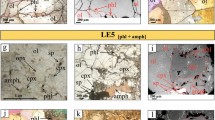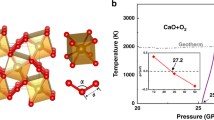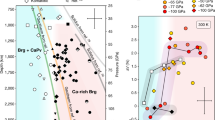Abstract
Because of its importance in understanding the static and dynamic properties of the Earth's mantle, the olivine to spinel structure transformation is one of the most frequently studied crystal structure changes. The volume change is considerable (∼7–10%, depending on the compound involved) but the reason for this is unclear. In most high-pressure transformations, the volume contraction is accompanied by an increase in the primary coordination number of the atoms. However, there is no such increase in the case of the transformation from the olivine to the spinel structure. Both are A2BX4 compounds (for example, Mg2SiO4 olivine and Al2MgO4 spinel) with cation coordinations AX6 (octahedral) and BX4 (tetrahedral) and anion coordinations XA3B (tetrahedral). Indeed the conventional description of both structures starts with approximately ‘close-packed’ (‘eutactic’1) anion arrays (hexagonal for olivine and cubic for spinel) with cations in one half of the octahedral interstices and one eighth of the tetrahedral interstices, suggesting that the volumes of each structure should be very similar for a given compound. Here we show that a less conventional, but more appropriate description of the structures resolves the volume problem and also sheds light on the crystal chemistry of these and related structures.
This is a preview of subscription content, access via your institution
Access options
Subscribe to this journal
Receive 51 print issues and online access
$199.00 per year
only $3.90 per issue
Buy this article
- Purchase on Springer Link
- Instant access to full article PDF
Prices may be subject to local taxes which are calculated during checkout
Similar content being viewed by others
References
O'Keeffe, M. Acta crystallogr. A33, 324 (1977).
Wenk, H.-R. & Raymond, K. N. Z. Kristallogr. Kristallgeom. 137, 86 (1973).
Hyde, B. G., Andersson, S., Bakker, M., Plug, C. M. & O'Keeffe, M. Prog. Solid State Chem. 12, 273 (1979).
Marumo, F., Isobe, M. & Akimoto, S. Acta crystallogr. B33, 713 (1977).
O'Keeffe, M. & Hyde, B. G., Trans. Am. Crystallogr. Ass. 15, 65 (1979).
O'Keeffe, M. & Hyde, B. G., in Structure and Bonding in Crystals (eds O'Keeffe, M. & Navrotsky, A.) (Academic, New York, 1981).
Author information
Authors and Affiliations
Rights and permissions
About this article
Cite this article
O'Keeffe, M., Hyde, B. Why olivine transforms to spinel at high pressure. Nature 293, 727–728 (1981). https://doi.org/10.1038/293727a0
Received:
Accepted:
Issue Date:
DOI: https://doi.org/10.1038/293727a0
This article is cited by
-
The crystal structure of disordered (Zr,Ti)O2 solid solution including srilankite: evolution towards tetragonal ZrO2 with increasing Zr
Physics and Chemistry of Minerals (2005)
-
Olivine to spinel transformation in Mg2SiO4 via faulted structures
Nature (1983)
-
A spinel to β-phase transformation mechanism in (Mg,Fe)2SiO4
Nature (1982)
Comments
By submitting a comment you agree to abide by our Terms and Community Guidelines. If you find something abusive or that does not comply with our terms or guidelines please flag it as inappropriate.



